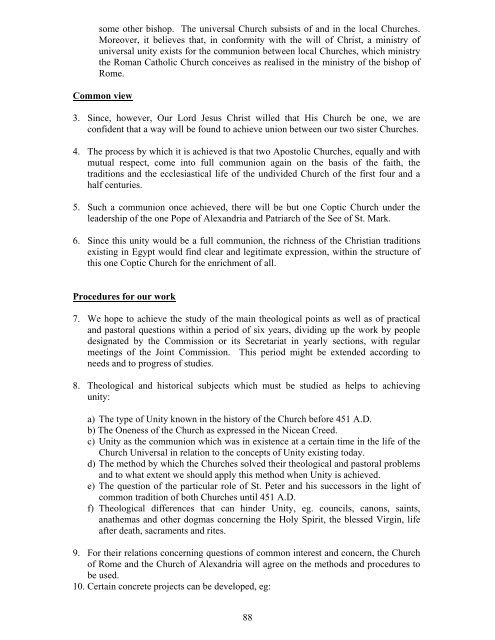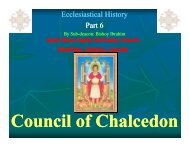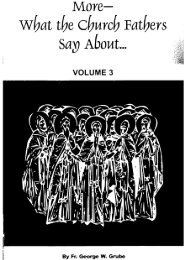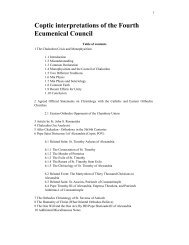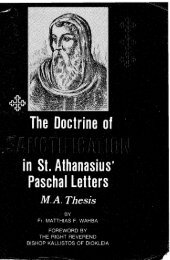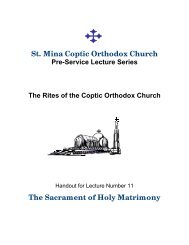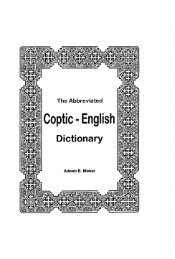Coptic Church & Ecumenical Movement - Saint Mina Coptic ...
Coptic Church & Ecumenical Movement - Saint Mina Coptic ...
Coptic Church & Ecumenical Movement - Saint Mina Coptic ...
You also want an ePaper? Increase the reach of your titles
YUMPU automatically turns print PDFs into web optimized ePapers that Google loves.
some other bishop. The universal <strong>Church</strong> subsists of and in the local <strong>Church</strong>es.<br />
Moreover, it believes that, in conformity with the will of Christ, a ministry of<br />
universal unity exists for the communion between local <strong>Church</strong>es, which ministry<br />
the Roman Catholic <strong>Church</strong> conceives as realised in the ministry of the bishop of<br />
Rome.<br />
Common view<br />
3. Since, however, Our Lord Jesus Christ willed that His <strong>Church</strong> be one, we are<br />
confident that a way will be found to achieve union between our two sister <strong>Church</strong>es.<br />
4. The process by which it is achieved is that two Apostolic <strong>Church</strong>es, equally and with<br />
mutual respect, come into full communion again on the basis of the faith, the<br />
traditions and the ecclesiastical life of the undivided <strong>Church</strong> of the first four and a<br />
half centuries.<br />
5. Such a communion once achieved, there will be but one <strong>Coptic</strong> <strong>Church</strong> under the<br />
leadership of the one Pope of Alexandria and Patriarch of the See of St. Mark.<br />
6. Since this unity would be a full communion, the richness of the Christian traditions<br />
existing in Egypt would find clear and legitimate expression, within the structure of<br />
this one <strong>Coptic</strong> <strong>Church</strong> for the enrichment of all.<br />
Procedures for our work<br />
7. We hope to achieve the study of the main theological points as well as of practical<br />
and pastoral questions within a period of six years, dividing up the work by people<br />
designated by the Commission or its Secretariat in yearly sections, with regular<br />
meetings of the Joint Commission. This period might be extended according to<br />
needs and to progress of studies.<br />
8. Theological and historical subjects which must be studied as helps to achieving<br />
unity:<br />
a) The type of Unity known in the history of the <strong>Church</strong> before 451 A.D.<br />
b) The Oneness of the <strong>Church</strong> as expressed in the Nicean Creed.<br />
c) Unity as the communion which was in existence at a certain time in the life of the<br />
<strong>Church</strong> Universal in relation to the concepts of Unity existing today.<br />
d) The method by which the <strong>Church</strong>es solved their theological and pastoral problems<br />
and to what extent we should apply this method when Unity is achieved.<br />
e) The question of the particular role of St. Peter and his successors in the light of<br />
common tradition of both <strong>Church</strong>es until 451 A.D.<br />
f) Theological differences that can hinder Unity, eg. councils, canons, saints,<br />
anathemas and other dogmas concerning the Holy Spirit, the blessed Virgin, life<br />
after death, sacraments and rites.<br />
9. For their relations concerning questions of common interest and concern, the <strong>Church</strong><br />
of Rome and the <strong>Church</strong> of Alexandria will agree on the methods and procedures to<br />
be used.<br />
10. Certain concrete projects can be developed, eg:<br />
88


